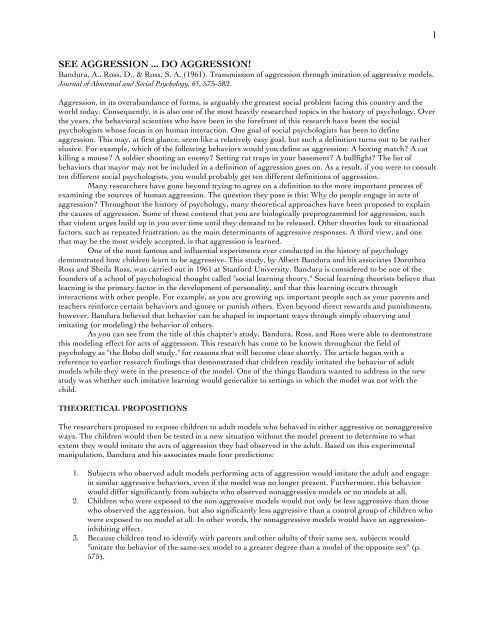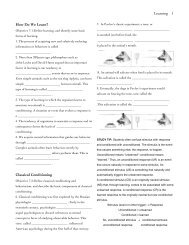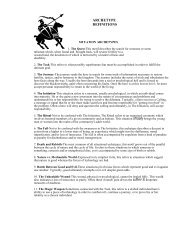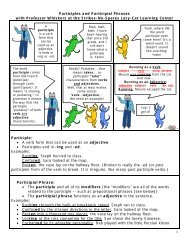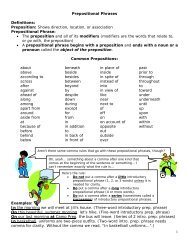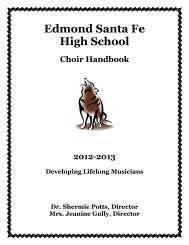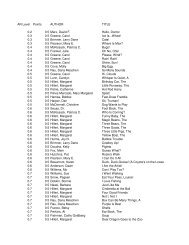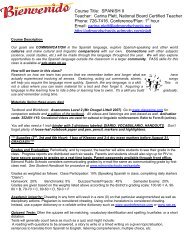1 SEE AGGRESSION ... DO AGGRESSION! - Edmond Public Schools
1 SEE AGGRESSION ... DO AGGRESSION! - Edmond Public Schools
1 SEE AGGRESSION ... DO AGGRESSION! - Edmond Public Schools
You also want an ePaper? Increase the reach of your titles
YUMPU automatically turns print PDFs into web optimized ePapers that Google loves.
<strong>SEE</strong> <strong>AGGRESSION</strong> ... <strong>DO</strong> <strong>AGGRESSION</strong>!<br />
Bandura, A., Ross, D., & Ross, S. A. (1961). Transmission of aggression through imitation of aggressive models.<br />
Journal of Abnormal and Social Psychology, 63, 575-582.<br />
Aggression, in its overabundance of forms, is arguably the greatest social problem facing this country and the<br />
world today. Consequently, it is also one of the most heavily researched topics in the history of psychology. Over<br />
the years, the behavioral scientists who have been in the forefront of this research have been the social<br />
psychologists whose focus is on human interaction. One goal of social psychologists has been to define<br />
aggression. This may, at first glance, seem like a relatively easy goal, but such a definition turns out to be rather<br />
elusive. For example, which of the following behaviors would you define as aggression: A boxing match? A cat<br />
killing a mouse? A soldier shooting an enemy? Setting rat traps in your basement? A bullfight? The list of<br />
behaviors that mayor may not be included in a definition of aggression goes on. As a result, if you were to consult<br />
ten different social psychologists, you would probably get ten different definitions of aggression.<br />
Many researchers have gone beyond trying to agree on a definition to the more important process of<br />
examining the sources of human aggression. The question they pose is this: Why do people engage in acts of<br />
aggression? Throughout the history of psychology, many theoretical approaches have been proposed to explain<br />
the causes of aggression. Some of these contend that you are biologically preprogrammed for aggression, such<br />
that violent urges build up in you over time until they demand to be released. Other theories look to situational<br />
factors, such as repeated frustration, as the main determinants of aggressive responses. A third view, and one<br />
that may be the most widely accepted, is that aggression is learned.<br />
One of the most famous and influential experiments ever conducted in the history of psychology<br />
demonstrated how children learn to be aggressive. This study, by Albert Bandura and his associates Dorothea<br />
Ross and Sheila Ross, was carried out in 1961 at Stanford University. Bandura is considered to be one of the<br />
founders of a school of psychological thought called "social learning theory." Social learning theorists believe that<br />
learning is the primary factor in the development of personality, and that this learning occurs through<br />
interactions with other people. For example, as you are growing up, important people such as your parents and<br />
teachers reinforce certain behaviors and ignore or punish others. Even beyond direct rewards and punishments,<br />
however, Bandura believed that behavior can be shaped in important ways through simply observing and<br />
imitating (or modeling) the behavior of others.<br />
As you can see from the title of this chapter's study, Bandura, Ross, and Ross were able to demonstrate<br />
this modeling effect for acts of aggression. This research has come to be known throughout the field of<br />
psychology as "the Bobo doll study," for reasons that will become clear shortly. The article began with a<br />
reference to earlier research findings that demonstrated that children readily imitated the behavior of adult<br />
models while they were in the presence of the model. One of the things Bandura wanted to address in the new<br />
study was whether such imitative learning would generalize to settings in which the model was not with the<br />
child.<br />
THEORETICAL PROPOSITIONS<br />
The researchers proposed to expose children to adult models who behaved in either aggressive or nonaggressive<br />
ways. The children would then be tested in a new situation without the model present to determine to what<br />
extent they would imitate the acts of aggression they had observed in the adult. Based on this experimental<br />
manipulation, Bandura and his associates made four predictions:<br />
1. Subjects who observed adult models performing acts of aggression would imitate the adult and engage<br />
in similar aggressive behaviors, even if the model was no longer present. Furthermore, this behavior<br />
would differ significantly from subjects who observed nonaggressive models or no models at all.<br />
2. Children who were exposed to the non aggressive models would not only be less aggressive than those<br />
who observed the aggression, but also significantly less aggressive than a control group of children who<br />
were exposed to no model at all. In other words, the nonaggressive models would have an aggressioninhibiting<br />
effect.<br />
3. Because children tend to identify with parents and other adults of their same sex, subjects would<br />
"imitate the behavior of the same-sex model to a greater degree than a model of the opposite sex" (p.<br />
575).<br />
1
2<br />
4. "Since aggression is a highly masculine-typed behavior in society, boys should be more predisposed than<br />
girls toward imitating aggression, the difference being most marked for subjects exposed to the male<br />
model" (p. 575).<br />
METHOD<br />
This article outlined the methods used in the experiment with great organization and clarity. Although somewhat<br />
summarized and simplified, these methodological steps are presented here.<br />
Subjects<br />
The researchers enlisted the help of the director and head teacher of the Stanford University Nursery School in<br />
order to obtain subjects for their study. Thirty-six boys and 36 girls, ranging in age from 3 years to almost 6<br />
years, participated in the study as subjects. The average age of the children was 4 years and 4 months.<br />
Experimental Conditions<br />
Twenty-four children were assigned to the control group, which meant that they would not be exposed to any<br />
model. The remaining 48 subjects were first divided into two groups: one exposed to aggressive models and the<br />
other exposed to nonaggressive models. These groups were divided again into male and female subjects. Finally,<br />
each of these groups were divided so that half of the subjects were exposed to same-sex models and half to<br />
opposite-sex models. This created a total of eight experimental groups and one control group. A question you<br />
might be asking yourself is this: What if the children in some of the groups are already more aggressive than<br />
others? Bandura guarded against this potential problem by obtaining ratings of each subject's level of<br />
aggressiveness. The children were rated by an experimenter and a teacher (both of whom knew the children<br />
well) on their levels of physical aggression, verbal aggression, and aggression toward objects. These ratings<br />
allowed the researchers to match all the groups in terms of average aggression level.<br />
The Experimental Procedure<br />
Each child was exposed individually to the various experimental procedures. First, the experimenter brought the<br />
child to the playroom. On the way, they encountered the adult model who was invited by the experimenter to<br />
come and join in the game. The child was seated in one corner of the playroom at a table containing highly<br />
interesting activities. There were potato prints (this was 1961, so for those of you who have grown up in the<br />
high-tech age, a potato print is a potato cut in half and carved so that, like a rubber stamp, it will reproduce<br />
geometric shapes when inked on a stamp pad) and stickers of brightly colored animals and flowers that could be<br />
pasted onto a poster. Next, the adult model was taken to a table in a different corner containing a tinker toy set, a<br />
mallet, and an inflated Bobo doll 5 feet tall. The experimenter explained that these toys were for the model to<br />
play with and then left the room.<br />
For both the aggressive and nonaggressive conditions, the model began assembling the tinker toys.<br />
However, in the aggressive condition, after a minute, the model attacked the Bobo doll with violence. For all the<br />
subjects in the aggressive condition, the sequence of aggressive acts performed by the model was identical:<br />
The model laid Bobo on its side, sat on it, and punched it repeatedly in the nose. The model then raised<br />
the Bobo doll, picked up the mallet, and struck the doll on the head. Following the mallet aggression, the<br />
model tossed the doll up in the air aggressively, and kicked it about the room. This sequence of<br />
physically aggressive acts was repeated three times, interspersed with verbally aggressive responses<br />
such as, "Sock him in the nose ... , Hit him down ... , Throw him in the air ... , Kick him ... , Pow ... ," and<br />
two non-aggressive comments, "He keeps coming hack for more" and "He sure is a tough fella." (p. 576)<br />
All this took about 10 minutes, after which tl1e experimenter came back into the room, said good-bye to the<br />
model, and took the child to another game room.<br />
In the nonaggressive condition, the model simply played quietly with the tinker toys for the 10-minute<br />
period and completely ignored the Bobo doll. Bandura and his collaborators were careful to ensure that all<br />
experimental factors were identical for all the subjects except for the factors being studied: the aggressive versus<br />
nonaggressive model and the sex of the model.
Arousal of Anger or Frustration<br />
Following the 10-minute play period, all subjects from the various conditions were taken to another room that<br />
contained very attractive toys, such as a fire engine, a jet fighter, a complete doll set including wardrobe, a doll<br />
carriage, and so on. The researchers believed that in order to test the subjects for aggressive responses, the<br />
children should be somewhat angered or frustrated, which would make such behaviors more likely to occur. To<br />
accomplish this, they allowed the subjects to begin playing with the attractive toys, but after a short time told<br />
them that the toys in this room were reserved for the other children. The subjects were also told, however, that<br />
they could play with some other toys in the next room.<br />
Test for Imitation of Aggression<br />
The final experimental room was filled with both aggressive and nonaggressive toys. Aggressive toys included a<br />
Bobo doll (of course!), a mallet, two dart guns, and a tether ball with a face painted on it. The nonaggressive toys<br />
included a tea set, crayons and paper, a ball, two dolls, cars and trucks, and plastic farm animals. Each subject<br />
was allowed to play in this room for 20 minutes. During this period, judges behind a one-way mirror rated each<br />
child's behavior on several measures of aggression.<br />
Measures of Aggression<br />
A total of eight different responses were measured in the subjects' behavior. In the interest of clarity, only the<br />
four most revealing measures will be summarized here. First, all acts that imitated the physical aggression of the<br />
model were recorded. These included sitting on Bobo, punching it in the nose, hitting it with the mallet, kicking<br />
it, and throwing it into the air. Second, imitation of the models' verbal aggression was measured by counting the<br />
subjects' repetition of the phrases, "Sock him, Hit him down, Pow," and so on. Third, other mallet aggression<br />
(i.e., hitting objects other than the doll with the mallet) were recorded. Fourth, nonimitative aggression was<br />
documented by tabulating all subjects' acts of physical and verbal aggression that had not been performed by the<br />
adult model.<br />
RESULTS<br />
The findings from these observations are summarized in Table 1. If you examine the results carefully, you will<br />
discover that three of the four hypotheses presented by Bandura, Ross, and Ross in the introduction were<br />
supported.<br />
3
4<br />
The children who were exposed to the violent models tended to imitate the exact violent behaviors they<br />
observed. There were an average of 38.2 instances of imitative physical aggression for each of the male subjects,<br />
and 12.7 for the female subjects who had been exposed to the aggressive models. Additionally, the models'<br />
verbally aggressive behaviors were imitated an average of 17 times by the boys and 15.7 times by the girls. These<br />
specific acts of physical and verbal aggression were virtually never observed in the subjects exposed to the<br />
nonaggressive models or in the control subjects who were not exposed to any model.<br />
As you will recall, Bandura and his associates predicted that nonaggressive models would have a<br />
violence-inhibiting effect on the children. In order for this hypothesis to be supported, the results should show<br />
that the subjects in the nonaggressive conditions averaged significantly fewer instances of violence than those in<br />
the no-model control group. In Table 1, if you compare the nonaggressive model columns with the control group<br />
averages, you'll see that the findings were mixed. For example, boys and girls who observed the nonaggressive<br />
male exhibited far less nonimitative mallet aggression than controls, but boys who observed the nonaggressive<br />
female aggressed more with the mallet than did the boys in the control group. As the authors readily admit, these<br />
results were so inconsistent in relation to the aggression-inhibiting effect of nonaggressive models that they were<br />
inconclusive.<br />
The predicted gender differences, however, were strongly supported by the data in Table 1. Clearly,<br />
boys' violent behavior was influenced more by the aggressive male model than by the aggressive female model.<br />
The average total number of aggressive behaviors by boys was 104 when they had observed a male aggressive<br />
model, compared with 48.4 when a female model had been observed. Girls, on the other hand, while their scores<br />
were less consistent, averaged 57.7 violent behaviors in the aggressive female model condition, compared with<br />
36.3 when they observed the male model. The authors point out that in same-sex aggressive conditions, girls<br />
were more likely to imitate verbal aggression while boys were more inclined to imitate physical violence.<br />
Finally, boys were significantly more physically aggressive than girls in nearly all the conditions. If all<br />
the instances of aggression in Table 1 are tallied, there were 270 violent acts by the boys, compared with 128 by<br />
the girls.<br />
DISCUSSION<br />
Bandura, Ross, and Ross claimed that they had demonstrated how specific behaviors—in this case, violent<br />
ones—could be learned through the process of observation and imitation without any reinforcement provided to<br />
either the models or the observers. They concluded that children's observation of adults engaging in these<br />
behaviors sends a message to the child that this form of violence is permissible, thus weakening the child's<br />
inhibitions against aggression. The consequence of this observed violence, they contended, is an increased<br />
probability that a child will respond to future frustrations with aggressive behavior.<br />
The researchers also addressed the issue of why the influence of the male aggressive model on the boys<br />
was so much stronger than the female aggressive model was on the girls. They explained that in our culture, as in<br />
most, aggression is seen as more typical of males than females. In other words, it is a masculine-typed behavior.<br />
So, a man's modeling of aggression carried with it the weight of social acceptability and was, therefore, more<br />
powerful in its ability to influence the observer.<br />
SUBSEQUENT RESEARCH<br />
At the time this experiment was conducted, the researchers probably had no idea how influential it would<br />
become. By the early 1960s, television had grown into a powerful force in American culture and consumers were<br />
becoming concerned about the effect of televised violence on children. This has been and continues to be hotly<br />
debated. In the past 30 years, there have been no fewer than three congressional hearings on the subject of<br />
television violence, and the work of Bandura and other psychologists has been included in these investigations.<br />
These same three researchers conducted a follow-up study two years later that was intended to examine<br />
the power of aggressive models who are on film, or who are not even real people. Using a similar experimental<br />
method involving aggression toward a Bobo doll, Bandura, Ross, and Ross designed an experiment to compare<br />
the influence of a live adult model with the same model on film and to a cartoon version of the same aggressive<br />
modeling. The results demonstrated that the live adult model had a stronger influence than the filmed adult, who,<br />
in turn, was more influential than the cartoon. However, all three forms of aggressive models produced<br />
significantly more violent behaviors in the children than was observed in children exposed to nonaggressive<br />
models or control subjects (Bandura, Ross, & Ross, 1963).
On an optimistic note, Bandura found in a later study that the effect of modeled violence could be<br />
altered under certain conditions. You will recall that in his original study, no rewards were given for aggression<br />
to either the models or the subjects. But what do you suppose would happen if the model behaved violently and<br />
was then either reinforced or punished for the behavior while the child was observing? Bandura (1965) tested<br />
this idea and found that children imitated the violence more when they saw it rewarded, but significantly less<br />
when the model was punished for aggressive behavior.<br />
Critics of Bandura's research on aggression have pointed out that aggressing toward an inflated doll is<br />
not the same as attacking another person, and that children know the difference. Building on the foundation laid<br />
by Bandura and his colleagues, other researchers have examined the effect of modeled violence on real<br />
aggression. In a study using Bandura's Bobo doll method (Hanratty, O'Neil, & Sulzer, 1972), children observed<br />
a violent adult model and were then exposed to high levels of frustration. When this occurred, they often<br />
aggressed against a live person (dressed like a clown), whether that person was the source of the frustration or<br />
not.<br />
RECENT APPLICATIONS<br />
Bandura's research discussed in this chapter made at least two fundamental contributions to psychology. First it<br />
demonstrated dramatically how children can acquire new behaviors simply by observing adults, even when the<br />
adults are not physically present. Social learning theorists believe that much, if not most, of the behaviors that<br />
comprise human personality are formed through this modeling process. Second, this research laid the<br />
groundwork for hundreds of studies over the past 40 years on the effects on children of viewing violence in<br />
person or in the media. (For a summary of Bandura's many contributions to psychology see<br />
http://www.ship.edu/ ~cgboeree/bandura .html,1998.)<br />
Within the past decade the U.S. Congress has held new rounds of hearings on media violence focusing<br />
on the potential effects of TV, movies, video games, computer games, and the Internet. In 2000, ajoint statement<br />
to Congress from six national medical associations including the American Medical Association, the American<br />
Academy of Pediatrics, and the American Psychological Association stated:<br />
At this time, well over 1000 studies ... point overwhelmingly to a causal connection between media<br />
violence and aggressive behavior in some children. The conclusion of the public health community,<br />
based on over 30 years of research, is that viewing entertainment violence can lead to increases in<br />
aggressive attitudes, values and behavior, particularly in children. Its effects are measurable and longlasting.<br />
Moreover, prolonged viewing of media violence can lead to emotional desensitization toward<br />
violence in real life (American Medical Association, 2000).<br />
Broadcasters and multimedia developers, feeling increased pressure to respond to public and legislative attacks,<br />
are working to reduce media violence or put in place parental advisory rating systems warning of particularly<br />
violent content.<br />
Perhaps of even greater concern is the mounting evidence demonstrating that the effects of violent<br />
media on children may continue into adulthood (Heusmann et al., 2003). One study found "that childhood<br />
exposure to media violence predicts young adult aggressive behavior for both males and females. Identification<br />
with aggressive TV characters and perceived realism of TV violence also predict later aggression. These relations<br />
persist even when the effects of socioeconomic status, intellectual ability, and a variety of parenting factors are<br />
controlled" (Heusmann et al., 2003, p. 201).<br />
As children acquire easier access to quickly expanding media channels and formats, concerns over the<br />
effects of violence embedded in the media are bound to increase as well. Because preventing children's access to<br />
violent media is probably an impossible task, research is increasingly focusing on strategies for preventing media<br />
violence from translating into real life aggression among children. These efforts have been stepped up<br />
considerably in the wake of school shootings at Columbine and other locations throughout the United States, and<br />
are likely to continue on many research fronts for the foreseeable future.<br />
American Medical Association. (2000). Media violence is harmful to kids-and to public health. Retrieved<br />
October 3, 2003 from, http://www.ama-assn.org/sci-pubs/amnews/pick_00/hlsb0814.htm.<br />
Bandura, A. (1965). Influence of models' reinforcement contingencies on the acquisition of imitative responses.<br />
Journal of Personality and Social Psychology, 1, 589-595.<br />
5
6<br />
Bandura, A., Ross, D., & Ross, S. (1963). Imitation of film mediated aggressive models. Journal of Abnormal and<br />
Social Psychology, 66, 3-11.<br />
Hanratty, M., O'Neil, E., & Sulzer,J. (1972). The effect of frustration on the imitation of aggression. Journal of<br />
Personality and Social Psychology, 21, 30-34. http://www.ship.edu/ ~cgboeree/ bandura.html (1998).<br />
Huesmann, L. R., Moise, J., Podolski, C. P., & Eron, L. D. (2003). Longitudinal relations between childhood<br />
exposure to media violence and adult aggression and violence: 1977-1992. Developmental Psychology, 39(2),<br />
201-221.


